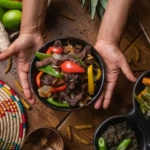The food and drink industry is always evolving, with new ingredients, cooking methods, and dining experiences emerging regularly. As we move into 2025, food trends are shifting toward health-conscious options, global flavors, and sustainable practices. In this article, we’ll explore some of the most exciting food trends for the year ahead, helping you stay ahead of the culinary curve.
1. Plant-Based Foods Continue to Shine
Plant-based eating isn’t just a trend anymore—it’s a lifestyle choice that’s becoming mainstream. In 2025, we’ll see even more innovation in the plant-based protein sector, with products like jackfruit, mushrooms, and legumes replacing traditional animal products. Expect to see plant-based versions of your favorite comfort foods, including burgers, cheese, and even sushi.
While health-conscious consumers have been driving this trend, it’s also helping reduce the environmental impact of the food industry. Whether you’re fully vegan or just looking to cut back on meat, plant-based options will continue to be a staple in 2025.
2. Fermented Foods and Probiotics
Fermented foods are gaining popularity, not just for their bold flavors, but for their health benefits. From kimchi to kefir, kombucha to miso, these foods are packed with gut-friendly probiotics that support digestion and overall wellness. In 2025, we can expect to see even more fermented foods on restaurant menus and grocery store shelves.
Fermented foods are not only delicious, but they also offer a variety of flavors, from tangy and sour to umami-packed. Keep an eye out for new fermented creations that incorporate trendy ingredients like miso butter or kombucha cocktails.
3. Global Flavors and Fusion Cuisine
In 2025, global fusion will continue to influence food trends, with flavors from Asia, Africa, and South America becoming more accessible and popular. Spicy and smoky flavors from Indian, Mexican, and Middle Eastern cuisines are making their way into mainstream menus, and we’re seeing an increase in fusion dishes that combine ingredients and cooking techniques from different cultures.
Expect to see more tacos with Korean BBQ, sushi burritos, and Indian-Mexican flavor mashups in the years ahead.
4. Zero-Waste Cooking
As sustainability becomes more important to consumers, zero-waste cooking is gaining traction. This practice involves using every part of an ingredient—from root to stem to leaf—minimizing food waste. In 2025, we’ll see more chefs and home cooks embracing zero-waste cooking by making creative use of leftovers, repurposing food scraps, and finding innovative ways to reduce waste.
Adopting this approach isn’t only eco-friendly, but it also opens up new flavors and textures to explore.
5. Non-Alcoholic Beverages on the Rise
With the rise of the mindful drinking movement, 2025 will see an increase in the availability and popularity of non-alcoholic beverages. From alcohol-free cocktails to mocktails and non-alcoholic beers, the demand for sophisticated, flavorful, and refreshing options is growing. These beverages appeal to a wide range of consumers, from those cutting back on alcohol to those seeking healthier choices.
The growing non-alcoholic beverage market offers endless creativity for both bartenders and consumers, so expect plenty of new drink innovations.
Conclusion: The Future of Food in 2025
As we enter 2025, food trends will be driven by health-conscious choices, sustainability, and global fusion. Whether you’re looking to try new plant-based products, explore fermented foods, or experiment with global flavors, there’s plenty to look forward to in the world of food and drink.




